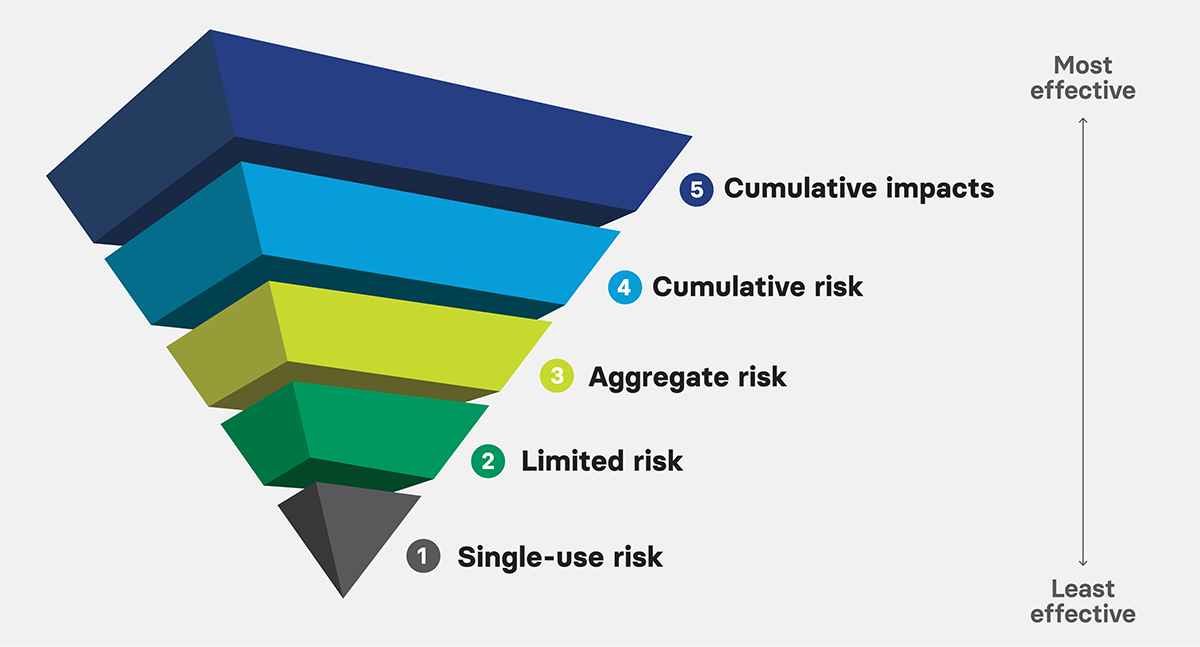New guidelines to inform EPA’s approach to cumulative risk
What’s New?
The Environmental Protection Agency (EPA) recently released and solicited public comments on its draft Cumulative Risk Assessment (CRA) Guidelines for Planning and Problem Formulation. The purpose of a CRA is to determine the combined health and/or environmental risks from multiple stressors and chemicals that can cause the same harms. These guidelines, intended to be applied to all of EPA’s programs and regions, describe how the agency will determine when to use CRAs and the steps it will take to plan them.
Why It Matters
Currently, many EPA programs assess the health and environmental risks of single chemicals, without considering the multiple chemicals that cause the same harms and non-chemical stressors we are exposed to every day. Assessing risks cumulatively, and making regulatory decisions based on this, represents real-world exposures more accurately than single-chemical stressor risk assessments.
CRAs are particularly important for assessing risks to vulnerable communities, such as those living at the fenceline of industrial pollution, as these communities are often exposed to multiple toxic chemicals and harmful pollutants – and at higher levels than other communities. They may also be subject to other non-chemical stressors that induce the same health effects, and thus worsen the effects of the toxic chemicals.
Figure 1: EDF developed the CRA Framework to demonstrate how narrow, single-chemical risk evaluations can be scaled up to a more effective and comprehensive assessment of cumulative risk that considers all relevant stressors.
Our Take
EPA is long overdue in terms of providing clear agency guidelines for conducting rigorous and transparent CRAs – as well as in adopting CRAs to assess the health and environmental risks of chemicals and stressors for its decision making. These guidelines are an important step for the agency to move toward conducting risk assessments in a cumulative, health-protective manner.
As a positive, these guidelines are broad enough to include various CRA techniques and applications, which can be applied by multiple programs at EPA. The guidelines also discuss integrating community vulnerability and non-chemical stressors into the planning and problem-formulation process. This will provide risk assessors with a fuller picture of a community’s real-world exposures and experiences – the cumulative impacts from these chemicals.
We noted in public comments that these guidelines are a step in the right direction, but EPA can go even further to ensure that CRAs properly include community involvement, do not dismiss risks prematurely, and decrease uncertainties. For example, EPA did not include guidelines on community engagement, but rather said that “the timing, frequency, and level of the community involvement process will depend on a number of factors.”
These guidelines fall short in their guidance on thoughtful and equitable community involvement, as planning with affected communities should be a core aspect of CRA planning and problem formulation. EPA should instead specifically include guidelines for best practices in community engagement. These include focusing on building trust within communities, making sure their concerns are continually heard, and integrating these concerns into outcomes within CRAs.
Next Steps
EPA will consider and respond to all public comments that were submitted on the new CRA guidelines before publishing their final guidelines for CRA planning and problem formulation. We encourage EPA to quickly build on these planning and problem-formulation guidelines and issue draft guidelines on conducting CRAs and characterizing and communicating risk. Until then, EDF and our partners will continue to urge EPA to conduct CRAs that fully consider and mitigate the risks multiple stressors pose to communities.













